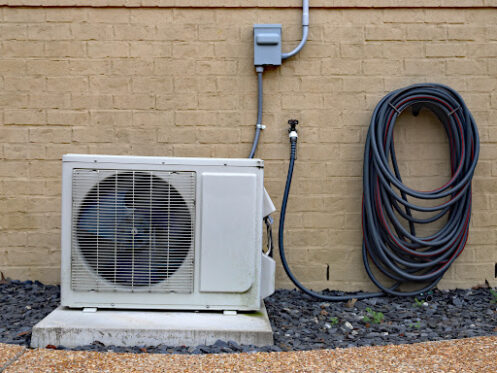Mini-splits can be a very effective and efficient alternative to central air conditioners. With central AC, you’d need ductwork in your home to transport the cool air into various areas. Mini-splits, on the other hand, don’t require ducts. This makes them much more practical for some customers. Mini-split HVAC systems are smaller than the average A/C setup, which may leave you wondering if it is able to cool an entire house. Let’s look at what mini-split units are capable of and which situations they work best in.
The Basics of Mini-Splits
If you’re considering getting a mini-split, it’s important to know how the system works. It requires you to get an outdoor unit and an indoor unit. The indoor unit will send out cool air, and it will be where heat is absorbed from your interior air. That heat will then get set to the outdoor unit via a conduit. That heat then gets transferred to the air surrounding your outdoor unit. The system relies on refrigerant, a material that’s also used in air conditioners and refrigerators. Refrigerant can absorb heat and give it off as it transitions between a gas and a liquid state.
There are a few scenarios in which mini-splits can be ideal. The first is if you have a home without ductwork and you’d like a way to easily cool your home. The second is if you do have central AC but have an additional space that’s not connected to your network of ducts. You may be looking for a way to keep that extra area more comfortable in the summer.
One Indoor Unit per Room
Unlike a central air conditioner that blows air through a series of ducts, an indoor mini-split unit sends cool air into its surroundings. An indoor unit in the kitchen will just cool the kitchen; it won’t be able to send that cold air into the bedroom, for example.
One indoor unit is needed in each room you’d like to cool. If you’d like each of your bedrooms to stay cooler in the summer, you’ll need to get a mini-split for each of those spaces.
Things may be a little different if you have an open layout in your home. For example, if your living and dining areas aren’t separated by walls, the cool air may be shared between these two spaces. In this case, you’ll want to be strategic about the placement of your mini-split. Having the unit installed on one end of the living area, as far away from the dining room as possible, might not be a very smart move. The cool air may struggle to get over to the other side of the shared space unless you have a fan to help move it there. Instead of isolating the mini-split on one side, it would be a better idea to put it in the middle of the two spaces. This allows both areas to benefit from the cool air.
Multiple Units
Getting more than one unit makes perfect sense if you’d like to cool more than one room in the home. The good news is that these indoor units can connect to the same outdoor unit. Some outdoor units can work with three or four indoor units, and more robust systems might even be compatible with seven or eight indoor units. This can save you the trouble of having to invest in more than one outdoor unit.
When you have more than one mini-split inside your home, you get to take advantage of multiple cooling zones. You can decide how cool you’d like each area to be. If some people like to sleep in very cold rooms at night while others in the home like to keep things warmer, getting different mini-splits can be a perfect way to address this situation.
If you’ve heard people talking about using mini-splits to cool their entire homes, they likely have more than one unit set up. Perhaps they don’t have central AC but wanted a more permanent solution than window or portable air conditioners. Getting multiple mini-split units could have given them relief from the heat.
Proper Sizing
Manufacturers make different sizes of mini-splits. When we refer to size, we’re not referring to the size of the actual unit. We’re referring to the cooling capacity of the system, and that corresponds with the amount of square footage it can cool. The industry uses BTUs to describe the size or cooling capacities of mini-split systems. BTUs stand for British Thermal Units, and they allow us to describe how much heat a unit can remove in one hour.
Smaller mini-splits are suited for smaller rooms. If you have a very small living room or bedroom, a mini-split with 7,000 or 8,000 BTUs will probably be sufficient. Getting something bigger will require a greater investment, and you won’t want to pay extra for something you don’t need.
A larger area will need a more powerful mini-split. To cool 400 square feet of space, you might need a unit with 10,000 BTUs. A 1,000-square-foot space may need a 21,000-BTU mini-split. If you have a very spacious common area, you might need two mini-splits on either side to handle your cooling needs. It does help that some models come with different airflow patterns so that you can customize how the air is circulated.
These numbers are just estimates. The amount of insulation you have, whether there are windows and exterior doors, and the height of your ceilings can all affect your decision. Fortunately, you won’t have to figure all of this out on your own. At Titan Air Solutions, we can help you figure out the best mini-split options for your home in the Fort Worth area.
A Local Resource
At Titan Air Solutions, we always strive to do a great job for our customers. Our technicians are all highly trained and skilled, thanks to many years of service in the field. We have more than three decades of combined HVAC experience. You’ll find our team to be professional, courteous, and friendly, so you can feel comfortable asking us anything. When you work with us, you won’t ever feel pressured to make any kind of decision, and we’ll be sure to give you our personal attention.
We’re proud of the many five-star ratings we’ve received from some of the people we’ve assisted, and we continue to work hard to earn the respect of new customers. At our locally-owned business, we specialize in installing, repairing, and maintaining HVAC systems. That includes traditional heaters, air conditioners, mini-splits, and heat pumps. Plus, we can take care of the installation or repair of your Wi-Fi thermostat. We also have extensive experience with ductwork and indoor air quality products. If you’re interested, we have a Titan Protection Plan that you can subscribe to, and you’ll be glad to hear that we have a no-frustration guarantee. Call Titan Air Solutions to schedule an appointment.


